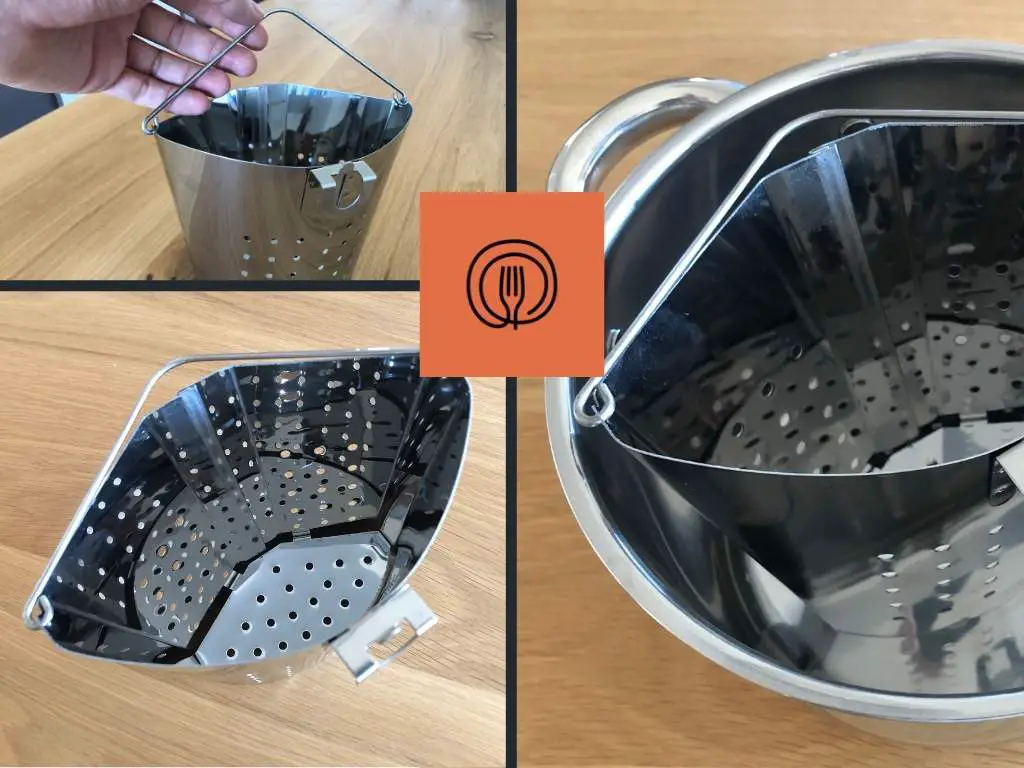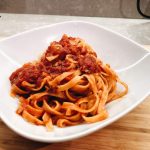Pasta is a staple in our household. And pasta noodles like tagliatelle and fettuccine, which come in long and strainy ribbons, are our favorite pasta varieties. This type of pasta usually comes in pasta nests, including when dried.
Pasta that comes in dried pasta nests is tasty, lasts for a long time, is made by some of the best Italian pasta brands, and is carried in most supermarkets. As someone who cooks and eats it maybe a little too often, I’m going to share with you my best advice on how to cook it.
What is the best way to cook dried pasta nests?
The best way to cook dried pasta nests is in salted water. Bring 4 quarts water per 1 pound pasta to a gentle boil in a large pot, salting the water with 1 tablespoon sea salt. When the water is at a boil, put the dried pasta nests in a pasta insert (pasta basket) and add them to the pot. Boil until they’re cooked on the inside, but remain firm to the bite on the outside.
This 4:1:1 ratio is also known as “the pasta ratio.” When you’re cooking pasta, add 4 quarts (16 cups) water per 1 pound noodles, salting the water with 1 tablespoon of salt. Remember the pasta ratio and forget about worrying whether or not you’re using enough water or salt.
Contrary to popular belief, salt doesn’t bring up the boiling temperature of the water enough to make a difference for your pasta, nor does it prevent the noodles from sticking. Instead, it seasons the pasta as it rehydrates and cooks, so that it comes out tasty instead of bland.
The pasta insert keeps the pasta from moving around in the pot as it cooks. It also makes straining the pasta much easier than holding the pot over a colander in the sink. When you’re using a pasta insert, all you have to do to strain the pasta is hold the insert over the pot for 5 to 10 seconds.

Don’t add olive oil to the pasta water. Oil and water molecules simply don’t mix. Most of the oil will end up floating on the surface of the pasta water. Some of the oil will coat the noodles with a layer that will do more harm to your pasta dish than good, as it will prevent them from absorbing pasta sauce later on.
When the pasta noodles are cooked, don’t rinse them. Instead, toss them with the sauce, no matter if tomato- or cream-based, in a frying pan over medium heat for 1-2 minutes. And scoop up 1 cooking spoonful of salty and starchy pasta water, adding it to your sauce as you do so. The water will enhance the taste and texture of your sauce. And the pasta will absorb it.
Once that’s done, plate the pasta. Optionally, grate some hard Italian cheese (like sheep’s milk Pecorino Romano or cow’s milk Parmigiano-Reggiano) on top of the pasta dish to add extra aromatics and flavor to your dish. Serve while hot and enjoy.
This is my recipe for cooking dried pasta noodles perfectly. Without hassle. Every. Single. Time.
Try it out for yourselves, folks. How did it turn out for you? Let me—and the rest of this post’s readers know—by leaving a comment below.
Now let’s take a deeper dive into a couple of the skills that every home cook needs to cook dried pasta nests to perfection.
By the end of this post (and the next time you make pasta), your family and friends will think that you’ve secretly gone to an Italian cooking course and never really intended to tell them.
How to Tell When Dried Pasta Nests Are Done
When it comes to cooking time, dried pasta nests are not that different from dried pasta as a whole. As someone obsessed with tagliatelle, fettuccine, and most other long and ribbony pasta varieties, here’s my best advice for how to cook them to perfection.
Dried pasta is best cooked until the noodles are nice and tender on the inside, but still firm to the bit and slightly crunchy on the outside. Italian chefs call this technique for cooking pasta “al dente,” which translates literally to “to the tooth.”
To cook al-dente pasta, boil the noodles for 2-3 minutes less than the recommended cooking time in the instructions on the package. As you get closer to that moment, start tasting the noodles every 30 seconds and use your senses to tell when they’re cooked al dente.
When some people first read about pasta cooked al dente, they worry that it’s bad for them. It’s actually better for you if you cook it that way.
When you overcook pasta, it comes out slimy and sticky. When you undercook pasta, it’s overly crunchy and hard to chew. Al dente is the middle ground when the inside of the noodles are cooked through, but the outside remains firm to the bite.
Pasta cooked al dente is actually easier for your body to digest. Because the noodles aren’t cooked to mush, your body needs more time to digest them slowly and gradually. This helps you avoid the blood sugar spike you typically get from eating overcooked pasta—giving you a steady source of energy from the starches and proteins in the noodles instead.
How to Toss Pasta With Sauce (The Right Way)
Most folks cook their pasta in salty water, strain it, discarting the cooking water, and toss the noodles with sauce in a large bowl or in the same pot they boiled them in.
That’s a super-valid technique for making pasta, as long as you don’t add olive oil to the cooking water and don’t rinse the noodles after they’re done. I’m going to tell you about a technique that doesn’t take that much more time and effort, yet leads to a whole lot tastier pasta.
Cook your pasta sauce in a saucepan as you’re boiling the noodles in a large pot. Strain the noodles when they’re done and add them to the frying pan, turning the heat on your cooktop down to medium, tossing and cooking them with the sauce for 1-2 minutes.
Doing so allows the noodles to absorb the sauce, which greatly improves the taste and texture of your pasta dish. To make it “perfect,” add 1 cooking spoonful of salty and starchy pasta water to the frying pan as you toss and cook the noodles with the sauce.
You can tell just how much of a difference this technique makes from a picture (the photos are of fusilli pasta, but the same principle applies to tagliatelle and fettuccine pasta nests):

Try this technique out when you’re in a hurry and you want to improve the taste of store-bought pasta sauce; it does miracles.
Nevertheless, I recommend making your own sauce with 1 tablespoon extra-virgin olive oil, a can of San Marzano tomatoes, 2-3 large cloves of garlic, and a pinch of sea salt on any day. It doesn’t take more time than it takes you to boil the pasta—and comes out tasting amazing.
How Long Do Dried Pasta Nests Last?
When it comes to pasta, it’s best to cook homemade or fresh pasta within 2-3 days from making or buying it. Commercially-dried pasta that’s sold in stores retains peak quality for up to 2 years.
Store-Bought Dried Pasta
Store-bought dried pasta can be stored indefinitely. However, its taste, texture, aromatics, and nutritional characteristics degrade over time. As a rule of thumb, the USDA recommends storing dried pasta for no longer than 2 years.
To maximize the shelf life of dried pasta nests, store them in an airtight container in a cool and dry place like your pantry or a kitchen cabinet. Avoid storing dried pasta in places where it’s exposed to direct sunlight or extreme temperatures.
Homemade Dried Pasta
Due to differences in the drying process, homemade dried pasta lasts significantly less than the commercially-dried pasta that’s sold in stores.
Whereas store-bought dried pasta lasts for up to 2 years, homemade dried pasta lasts anywhere from 2 to 6 months when stored in an airtight container in a cool and dry place. When frozen, homemade dried pasta can last for up to 8 months.
The Bottom Line
Cook dried pasta nests in a large pot and with a pasta insert (pasta basket).
Add 4 quarts water for every 1 pound pasta, salting the water 1 tablespoon sea salt (or any other salt you have in your home kitchen).
Boil the dried pasta nests 2-3 minutes less than the recommended cooking time in the instructions on the package. By that time, the noodles should be al dente; tender on the inside, but firm to the bite and with a slight crunch on the outside.
As soon as your pasta noodles are done, toss and continue cooking them for 1-2 minutes with the sauce, in a frying pan, over medium heat. Add 1 cooking spoonful of salty and starchy pasta water to elevate the taste and texture of your pasta dish.
Plate, serve, and enjoy. Then share your experience and your tips with our community of readers in the comments below 🙂 .
How to Cook Dried Pasta Nests
Equipment
- Pot
- Pasta insert
- Cooking spoon
- Frying pan
Materials
- 0.5 lb pasta nests (Fettuccine, tagliatelle, or another long pasta variety)
- 0.5 tbsp salt (Sea salt or any other type of salt)
- 2 quarts water (Tap water)
Instructions
Boil the Pasta Nests
- In the pot, salt the water and bring it to a gentle boil over medium-high heat
- Put the pasta nests in the pasta insert, then place the pasta insert in the pot of gently-boiling water
- Cook 2-3 minutes less than the recommended cooking time in the instructions on the package
- When the pasta noodles are tender on the inside, but still firm to the bite on the outside (al dente), they're done
Toss the Pasta Noodles With the Pasta Sauce
- Given that your pasta sauce is just done and still in the frying pan over medium heat, strain the noodles and transfer them to the frying pan
- Scoop up 1 cooking spoonful of salty and starchy pasta water, adding it to the pasta sauce and pasta noodles in your frying pan
- Toss and cook the noodles, stirring lightly every so often, for 1-2 minutes, letting the pasta water incorporate with the sauce—and the noodles absorb it
- Plate and serve, optionally grinding some hard Italian cheese (like Parmigiano-Reggiano or Pecorino Romano) on the pasta dish


